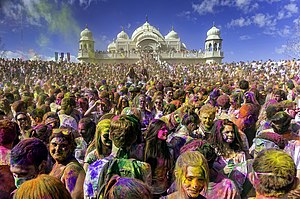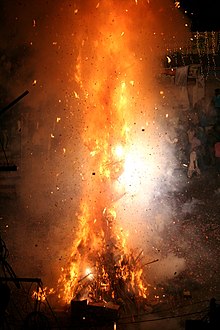Holi (pronunciation: /ˈhoʊliː/; Sanskrit: होलीHolī) is a spring festival, also known as the festival of colours or the festival of sharing love.[3][4] It is an ancient Hindu religious festival which has become popular with non-Hindus in many parts of South Asia, as well as people of other communities outside Asia.[5]
It is primarily observed in India, Nepal, and other regions of the world with significant populations of Hindus or people of Indian origin. In recent years the festival has spread to parts of Europe and North America as a spring celebration of love, frolic, and colours.[6][7][8]
Holi celebrations start on the night before Holi with a Holika bonfire where people gather, sing, dance and party. The next morning is a free-for-all carnival of colours,[5]where participants play, chase and colour each other with dry powder and coloured water, with some carrying water guns and coloured water-filled balloons for their water fight. Anyone and everyone is fair game, friend or stranger, rich or poor, man or woman, children and elders. The frolic and fight with colours occurs in the open streets, open parks, outside temples and buildings. Groups carry drums and other musical instruments, go from place to place, sing and dance. People visit family, friends and foes to throw colour powders on each other, laugh and gossip, then share Holi delicacies, food and drinks. Some drinks are intoxicating. For example, Bhang, an intoxicating ingredient made from cannabis leaves, is mixed into drinks and sweets and consumed by many.[9][10] In the evening, after sobering up, people dress up and visit friends and family.[1][11]
Holi is celebrated at the approach of the vernal equinox,[5] on the Phalguna Purnima(Full Moon). The festival date varies every year, per the Hindu calendar, and typically comes in March, sometimes February in theGregorian Calendar. The festival signifies the victory of good over evil, the arrival of spring, end of winter, and for many a festive day to meet others, play and laugh, forget and forgive, and repair broken relationships, and is also celebrated as a thanksgiving for a good harvest.[5][12]
History and Significance
See also: Holika
There is a symbolic legend to explain why Holi is celebrated as a festival of colours. The word "Holi" originates from "Holika", the evil sister of the demon king Hiranyakashipu. The festival itself is believed to have origins from the Prahlada-Puri Temple[13] of Multan in thePunjab region.[14] The original temple of Prahladpuri is said to have been built byPrahlada, Hiranyakashipu's son.[15]
King Hiranyakashipu,[16] according to legend, was the King of Multan[17] and had earned aboon that made him virtually indestructible. He grew arrogant, thought he was God, and demanded that everyone worship only him.[1]
Hiranyakashipu's own son, Prahlada,[18]however, disagreed. He was and remained devoted to Lord Vishnu.[11] This infuriated Hiranyakashipu. He subjected Prahlada to cruel punishments, none of which affected the boy or his resolve to do what he thought was right. Finally, Holika - Prahlada's evil aunt - tricked him into sitting on a pyre with her.[1]Holika was wearing a cloak that made her immune to injury from fire, while Prahlada was not. As the fire roared, the cloak flew from Holika and encased Prahlada.[11] Holika burned, Prahlada survived. Seeing this, Hiranyakashipu, unable to control his anger, smashed a pillar with his mace. There was a tumultuous sound, and Lord Vishnu appeared as Lord Narasimha and killed Hiranyakashipu. The bonfire is a reminder of the symbolic victory of good over evil, of Prahlada over Hiranyakashipu, and of the fire that burned Holika.[12] The next day when the fire cooled down, people applied ash to their foreheads,[19] a practice still observed by some people.[20] Eventually, coloured powder came to be used to celebrate Holi.
Importance of the Festival
In the Braj region of India, where the Hindu deity Krishna grew up, the festival is celebrated for 16 days (until Rangpanchmi) in commemoration of the divine love of Radhafor Krishna. The festivities officially usher in spring, with Holi celebrated as a festival of love.[21] There is a symbolic myth behind commemorating Krishna as well. As a baby, Krishna developed his characteristic dark blue skin colour because the she-demonPutana poisoned him with her breast milk.[22]In his youth, Krishna despaired whether the fair-skinned Radha and other girls would like him because of his skin colour. His mother, tired of the desperation, asks him to approach Radha and colour her face in any colour he wanted. This he does, and Radha and Krishna became a couple. Ever since, the playful colouring of Radha's face has been commemorated as Holi.[23][24] Beyond India, these legends to explain the significance of Holi (Phagwah) are common in some Caribbean and South American communities of Indian origin such as Guyana and Trinidad and Tobago.[25][26] It is also celebrated with great fervour in Mauritius.[27]
The Holi festival has further cultural significance. It is the festive day to end and rid oneself of past errors, to end conflicts by meeting others, a day to forget and forgive. People pay or forgive debts, as well as deal anew with those in their lives. Holi also marks the start of spring, and for many the start of the new year.[12][28]
Description
Holi is an important festival to Hindus. It is celebrated at the end of winter, on the last full moon day of the lunar month Phalgun(February/March), (Phalgun Purnima), which usually falls in March, sometimes in late February.[29]
The festival has many purposes; most prominently, it celebrates the beginning of Spring. In 17th century literature, it was identified as a festival that celebrated agriculture, commemorated good spring harvests and the fertile land.[5] Hindus believe it is a time of enjoying spring's abundant colours and saying farewell to winter. To many Hindus, Holi festivities mark the beginning of the new year as well as an occasion to reset and renew ruptured relationships, end conflicts and rid themselves of accumulated emotional impurities from the past.[12][28]
It also has a religious purpose, symbolically signified by the legend of Holika. The night before Holi, bonfires are lit in a ceremony known as Holika Dahan (burning of Holika) or Little Holi. People gather near fires, sing and dance. The next day, Holi, also known as Dhuliin Sanskrit, or Dhulheti, Dhulandi or Dhulendi, is celebrated. Children and youth spray coloured powder solutions (gulal) at each other, laugh and celebrate, while adults smear dry coloured powder (abir) on each other's faces.[1][28] Visitors to homes are first teased with colours, then served with Holi delicacies, desserts and drinks.[30] After playing with colours, and cleaning up, people bathe, put on clean clothes, and visit friends and family.[12]
History and rituals
Holi is an ancient Hindu festival with its cultural rituals. It is mentioned in the Puranas, Dasakumara Charita, and by the poetKālidāsa during the 4th century reign of Chandragupta II.[3] The celebration of Holi is also mentioned in the 7th-century Sanskrit drama Ratnavali.[32] The festival of Holi caught the fascination of European traders and British colonial staff by the 17th century. Various old editions of Oxford English Dictionary mention it, but with varying, phonetically derived spellings: Houly (1687),Hooly (1698), Huli (1789), Hohlee (1809),Hoolee (1825), and Holi in editions published after 1910.[5]
There are several cultural rituals associated with Holi:[33]
- Prepare Holika pyre for bonfire
Main article: Holika Dahan
Days before the festival people start gathering wood and combustible materials for the bonfire in parks, community centers, near temples and other open spaces. On top of the pyre is an effigy to signify Holika who tricked Prahalad into the fire. Inside homes, people stock up on pigments, food, party drinks and festive seasonal foods such asgujiya, mathri, malpuas and other regional delicacies.
- Holika dahan
On the eve of Holi, typically at or after sunset, the pyre is lit, signifying Holika Dahan. The ritual symbolises the victory of good over evil. People gather around the fire to sing and dance.[12]
- Play with colours
Holi frolic and celebrations begin the morning after the Holika bonfire. There is no tradition of holding puja (prayer), and the day is for partying and pure enjoyment. Children and young people form groups armed with dry colours, coloured solution, the means to fill and spray others with coloured solution (pichkaris), water balloons filled with coloured water, and other creative means to colour their targets.[33]
Traditionally, washable natural plant-derived colours such as turmeric, neem, dhak, andkumkum were used, but water-based commercial pigments are increasingly used. All colours are used. Everyone in open areas such as streets and parks is game, but inside homes or at doorways only dry powder is used to smear each other's face. People throw colours and get their targets completely coloured up. It is like a water fight, but with coloured water. People take delight in spraying coloured water on each other. By late morning, everyone looks like a canvas of colours. This is why Holi is given the name "Festival of Colours".
Groups sing and dance, some playing drums and dholak. After each stop of fun and play with colours, people offer gujiya, mathri,malpuas and other traditional delicacies.[35]Cold drinks, including adult drinks based on local intoxicating herbs,[9] are also part of the Holi festivity.
- Other variations
In the Braj region around Mathura, in north India, the festivities may last more than a week. The rituals go beyond playing with colours, and include a day where men go around with shields and women have the right to playfully beat them on their shields with sticks.[36]
In south India, some worship and make offerings to Kaamadeva, the love god of Indian mythology, on Holi.
- The after party
After a day of play with colours, people clean up, wash and bathe, sober up and dress up in the evening and greet friends and relatives by visiting them and exchanging sweets. Holi is also a festival of forgiveness and new starts, which ritually aims to generate harmony in the society.[33]






No comments:
Post a Comment